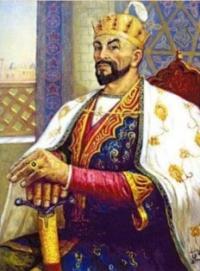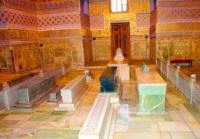Вы здесь
Amir Temur - Seyid Berke’s tombs.


Tours on Central Asian Ring around Central Asia.
“An ancient burial site will always hold clues as to who the people were, and to who we are”
Anthony T. Hincks.
Adventure tour in Uzbekistan.
The name of the mausoleum reflects its two essences: Gur-Emir - a tomb of emir (Amir Temur), Guri-Mir - the world of Seyid Berke. In the XVIIth century, when Muhammad-Sultan’s madrasah still operated, but khanaka had already ruined, the mausoleum was named after Seyid Berke.
His tomb is located in the northern sector of the mausoleum so, that all other tombs were placed “at his foot”. Seyid Berke came from Mecca or Medina and was one of Mecca’s sheriffs. About 1370, Seyid arrived to Khurasan about business of vakf (land patent) in holy cities, but Emir Husein did not show proper respect to him.
Then, Seyid Bereke addressed to Amir Temur and gave a drum and banner, so recognizing him as a king. From that moment, Seyid Berke enjoyed a position of the most esteemed spiritual teacher at court of Sohinkiran.
He was given lands of Andhoi (in the north of Afghanistan) as vakf in Islamic holy cities. Seyid Berke died earlier than Amir Temur, but Shahruh, doing father’s will, reburied the remains of saint seyid in Gur-Emir.
Temur was buried in a marble sarcophagus bedded in the ground. Inside the sarcophagus there is a wooden coffin from archa or sycamine. The gravestone in the upper hall is made of precious black nephrite.
After conquest of Bukhara khanate in 1740, Iranian shah Nadir ordered to deliver the Amir Temur's nephrite gravestone to Mashhad, but later turned it back. The Arabic inscription on the gravestone reads: “This tomb of the greatest sultan and the noblest khakan Temur Guragan, the son of amir Taragai, the son of amir Bargul, the son of amir Ailanghir, the son of amir Idjil, the son of Qaradjar Noyana, the son of amir Sugudjindjin, the son of amir Irdanchi "baruslas", the son of amir Kachulai, the son of Tumanai khan.
This is a link where a line of Chinggis-khan separated from this genealogical tree. Sultan the noblest in the world was born, now buried in this esteemed and brilliant tomb. Kaan, Chinggis khan, the son of amir Yiesukai bahadur, the son of amir Bartan bahadur, the son of Kabul khan, the son of above mentioned Tumanai-khan; at the same time, he is the son of amir Basungar, the son of Kaidu khan, the son of amir Tutumtin, the son of amir Buki, the son of amir Buzandjir.
The father of this noble man was not known, except for his mother was Alankuva. It is said, that she was truthful and pure she conceived him from the light, which came to her from the heaven door and appeared before her as a perfect person.
He said that he is a son of the lord of true Muslims, ‘Ali, the son of Abu Talib. And many times her (Alankuva’s] relation with him [the son of ‘Ali) was proved by her noble descendants, at all times becoming winners over everybody.
He (Amir Temur) died at night 14 sa'bana 807H”. The marble gravestone in the chamber contains the Arabic inscription repeating the major content of the text on the gravestone in the upper hall.
The inscriptions inform that the Temurids, in a line with Chinggisids, come from saint Alankuva, and equally claim on cognation with ‘Ali, the nephew of Prophet Muhammad. Since the nephrite gravestone was brought in 1425 from Mogolistan under order of Ulugbeg, these texts, most likely, express his opinion.
Authority:
Alexey Arapov. Samarkand. Masterpieces of Central Asia. Tashkent, Sanat. 2004.
Photos
Alexander Petrov.







